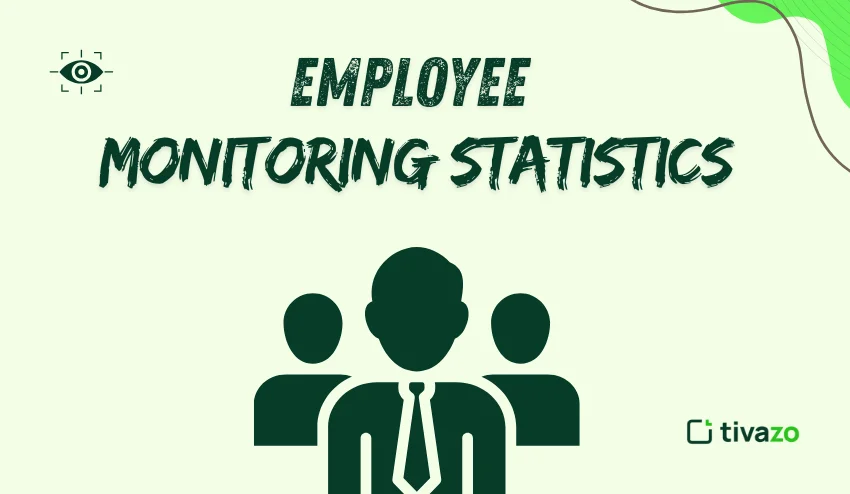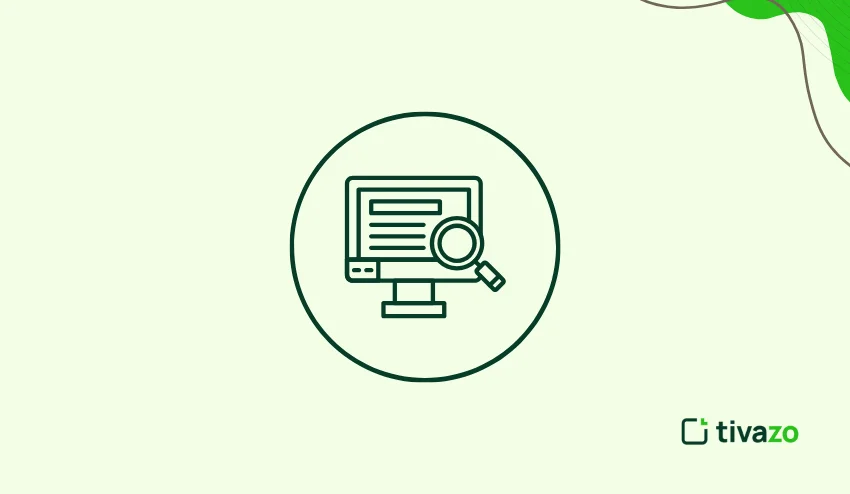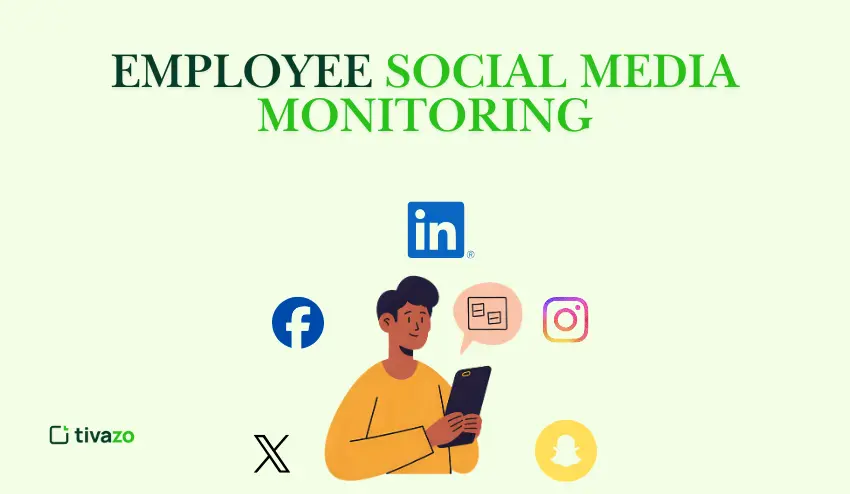With regards to supervision in the workplace, employee monitoring has now advanced from the peripheral to a mainstream practice governing how organizations regulate performance, security, and remote work. But how extensive is it? What does the data reveal about its benefits and drawbacks? In this full-length post on employee monitoring statistics, we’ll peel back the layers on the statistics, discuss the associated motives, look at employee sentiment at work, and demonstrate how Tivazo can deliver a more balanced option.
Today, employee monitoring statistics say a lot about figuring out how work culture has shifted, from an in-person office-based supervisory model to an online culture of digital surveillance through AI and analytics. Organizations are using employee monitoring statistics to drive decision-making, assess workforce effectiveness, and address insider risks. It provides a valuable feedback loop for establishing productivity gaps, improving accountability, and managing compliance challenges in hybrid work.
While employee monitoring statistics can facilitate transparency and improvement, it also raise legitimate concerns about trust, privacy, and workplace ethics. Therefore, in workplace management, balancing some level of control and some level of independence is the real challenge of today’s workforce management.
What Is Employee Monitoring?
Employee monitoring statistics is the process of watching and tracking employees’ work-related behaviors or work-related digital activity, or the physical presence of employees, by software, hardware, or surveillance technologies.
More specifically, we can look at it as inclusive of:
- Time-tracking (login, logout, hours worked)
- Screen captures / screenshots
- Keystroke logging
- Application / URL usage
- Email/chat communications
- Video or CCTV monitoring
- GPS / location tracking
- Biometric or access control logs
The intent of monitoring is to secure company resources, assess performance, facilitate compliance, or even minimize misuse. Companies are using monitoring more as the incidences of monitoring climb to record levels, to improve productivity, increase accountability, and, importantly, secure productive remote work environments while maintaining transparency and engagement across teams.
How Common Is Employee Surveillance?
Here are some statistics on employee monitoring demonstrating how common monitoring has become:
- According to Gartner, 71% of employees are digitally monitored- that’s an increase of roughly 30% from a year ago.
- 78% of employers use monitoring software to track performance or online activity.
- 90% of companies actively monitor time on and off the clock (i.e., time spent working).
- 96% of organizations use time-tracking technology, and by 2025, approximately 70% of larger companies will be monitoring employees.
- More than 73% of employers monitor remote or hybrid employees, and 75% of employers monitor employee work in an in-person workplace.
- 43% of employees designated as remote/hybrid indicated that their employer monitors online activity (48% hybrid, 37% fully remote).
- 67.6% of large U.S. organizations (>500 employees) utilize some monitoring software.
- In the U.K., approximately 1 out of 3 employers currently use “Bossware” for monitoring computer activity.
These employee monitoring statistics illustrate that employee monitoring is no longer just a thing only niche organizations practice- it has gone entirely mainstream, and organizations monitor their employees, especially in hybrid/remote workplaces.
Trends Over Time and Forecasts
- “Employee monitoring software” has experienced significant growth in the last couple of years, with revenue of $587.8 million, with about 12% annual growth.
- A global report has shown that 65% of businesses have started using employee monitoring software.
- It is believed that 70% of larger employers will use some methods to monitor employees in 2025, growing from approximately 60% in recent years.
- Video surveillance is increasing in usage; some sources report that approximately 69% of businesses are monitoring with video in office environments.
- With these employee monitoring statistics, it is expected that employee monitoring will continue to increase, especially as remote/hybrid models continue.
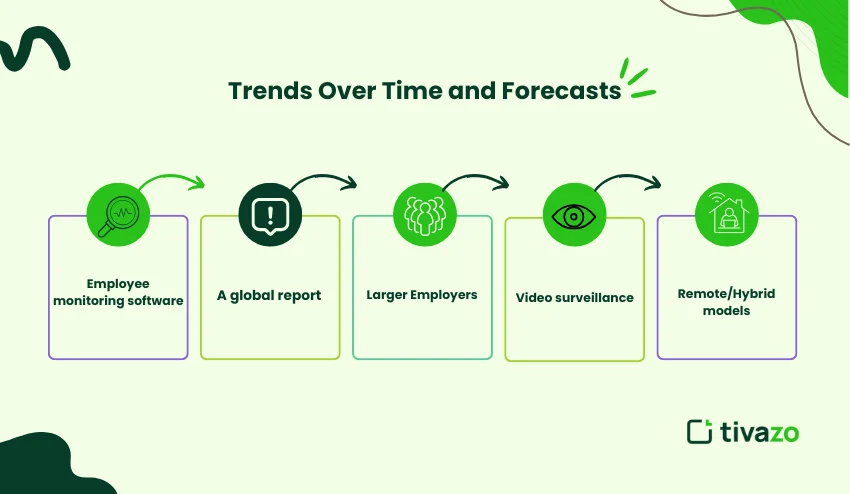
Why Companies Choose to Monitor Their Employees?
Understanding the reasons for monitoring your employees will not only provide some context around the statistics in their use, but also help ensure monitoring is even more fair and effective.
Measuring productivity & performance
Many organizations believe monitoring allows them to assess employee productivity and performance, measure unwanted periods of idle time, and improve workflows.
Time tracking & billing
For companies that charge hourly, tracking the hours worked is important information to bill clients, as well as preventing “time theft“.
Security/compliance/risk mitigation
Preventing costly data leaks, mitigating insider threats, and preventing unauthorized use of systems a significant reasons for monitoring.
Digital workplace control
With less in-person oversight, companies choose to rely on digital monitoring systems to enforce accountability.
Resource allocation & optimization
Monitoring may be more strategic and provide a foundation for scheduling, capacity planning, and areas needing improvement.
According to the most recent employee monitoring statistics, about 70% of businesses surveyed utilize tracking software to enhance visibility into their operations and employees’ performance.
From these employee monitoring statistics, we see that data-driven monitoring can increase productivity but will also enhance workplace discipline and trust with proactive, transparent usage. For companies today, it appears that instead of micromanaging, the focus will center on performance analytics to leverage employee monitoring statistics for business decision-making towards fairness, optimization, and sustainability.
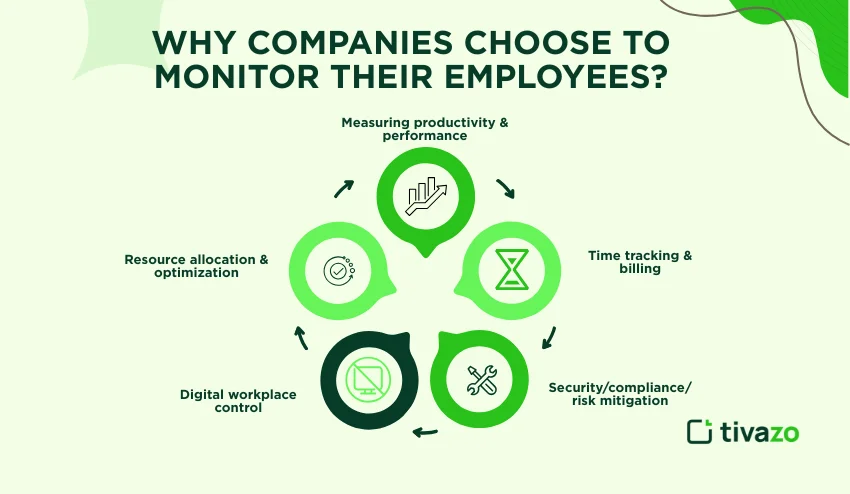
What Types of Monitoring Do Organizations Conduct?
A review of the common types of monitoring (and their employee monitoring statistics):
| Type of Monitoring | Typical Uses/Frequency |
| Time & attendance | 96% of companies use time-tracking tools. |
| Software/application usage & URLs | Tracking what tools or sites employees engage with (useful / under-utilized). |
| Checkpoints/screenshots | ~78% of “productivity tools” take screenshots. |
| Keystroke logging | Used for real-time monitoring of activity. |
| Email/chat logging | ~32% reported calls, messages, and meeting logs were being recorded. |
| Video / CCTV | ~69% reported use of video in office settings. |
| GPS/location utilities | Especially for workers in the field/mobile workers. |
| Biometric/access logging | 58.3% reported biometric access monitoring |
| Idle time/inactivity notification | Most tools would be triggered based on no activity (e.g., Tivazo features). |
The employee monitoring statistics highlight how companies track various activities to monitor productivity, security, and transparency. Companies aim to better understand an organization’s workflows through employee engagement with digital formats and applications. This can outline workflow efficiency and how often they are utilizing software, along with potential threats. In short, employee monitoring statistics are used to revise and enhance future behaviour alongside organizational performance.
What Do Employees Think of Monitoring?
While monitoring goes on regularly, it’s not something employees typically want.
Monitoring employees can lead to understandable concerns about the future of work and the employee experience. To consider some employee monitoring statistics about sentiment:
- While over 40% of employees know they’re being monitored and many don’t like it, only nearly half report stress or negative morale.
- 43% of remote workers say monitoring decreases morale, and 39% say it hurts employer-employee relations.
- Surveys found that 43% of employees believe monitoring violates trust; 59% reported anxiety; and 26% expressed resentment.
- The Indeed article also points out that monitoring is linked to increased stress, breaking the rules, and a damaging company culture.
- GDPR and privacy enforcement actions indicate pushback (e.g., fines against businesses for going too far).
Ultimately, employee monitoring statistics about sentiment demonstrate a precarious balance. Employee monitoring statistics often backfire due to loss of trust, employee engagement, and loyalty. However, monitoring employees can lead to accountability, productivity, and shared understanding of employer-employee relationships as long as the process is clear, regular communication is happening, consent is provided, and the purpose is known.
Why Should Organizations Monitor Their Employees?
It’s easy to focus on the negative, but there is plenty of valid reasoning on the positive side (as long as it is executed ethically):
- Transparency & fairness in remuneration: Confirming that the billed hours or hours worked are correlated to what is expected.
- Accountability & clarity of performance: Hard data can help substantiate a performance review solidly and objectively, and clearly.
- Reduced operational risk: Reduction of data loss, misuse of systems, and insider threats
- Resource planning & optimization: Using analytics to understand the use of employee bandwidth, downtime, and reallocate tasks.
- Regulatory compliance & auditing: In many industries with compliance, like finance or health care, logs can be required.
- Risk Remote/hybrid monitoring: Monitoring can help underpin a digital view without physical presence.
Common sense organizational monitoring does not infringe upon employees; it should not always be invasive, secretive, or punitive. Transparency, limitations, and fairness are imperative to acknowledge the employee monitoring statistics.
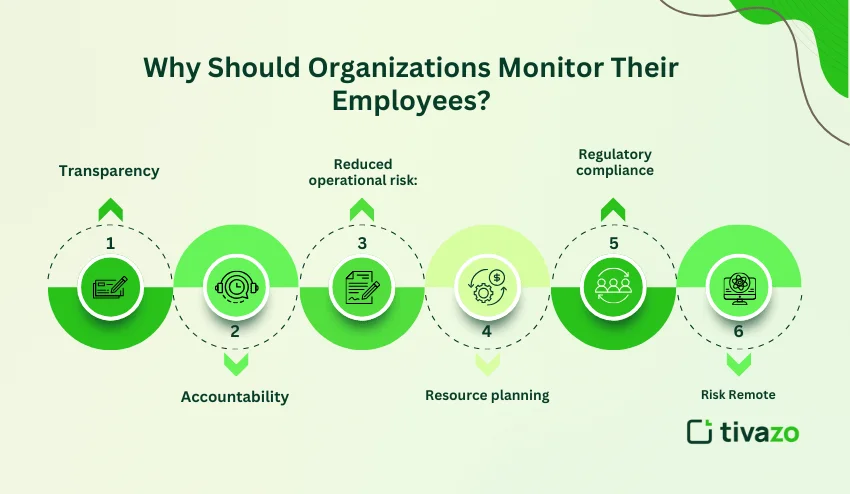
The Future of Monitoring Employees
An interesting exercise in imagining what we might expect to see based on the current trends and corresponding projections:
Emerging Trends & Observations
- Continuous adoption of AI/behavioral analytics: The tools we provide will increasingly use AI to identify patterns, anomalies, or risk signals.
- Edge computing/privacy-based solutions: Employees will increasingly use tools that utilize the processing power of their own devices to minimize data transfer and maintain privacy.
- Increased regulation/legal scrutiny: Privacy laws will increase the standard of what can be monitored by employers (ie, GDPR, CCPA, etc)
- Employee consent/opt-in paradigms: We can see some workplaces adopting a more participative approach, whereby employees know and consent to being monitored.
- Integration of well-being/mental health tools: Monitoring would regularly include metrics/signals associated with non-performance (ie, stress, burnout signals, etc).
- Zooming in further on “bossware“: The term “bossware” is gaining media attention as well as scrutiny from a regulatory approach.
Risks and Limitations
- Privacy lawsuits or fines: Regulators will impose notice/monetary fines for overreaching aspects of surveillance (e.g., the fine that Amazon could have received in France for extensive surveillance).
- Talent retention/trust loss: Employees could seek other employment if they experience more sophistication in monitoring than they choose.
- Data misuse/security risks: Data from work behavior has itself become a liability in monitoring if used maliciously or unauthorized.
- Algorithm bias and false positives: Automated systems will misdetermine legitimate behavior as problematic behavior, causing unfair consequences.
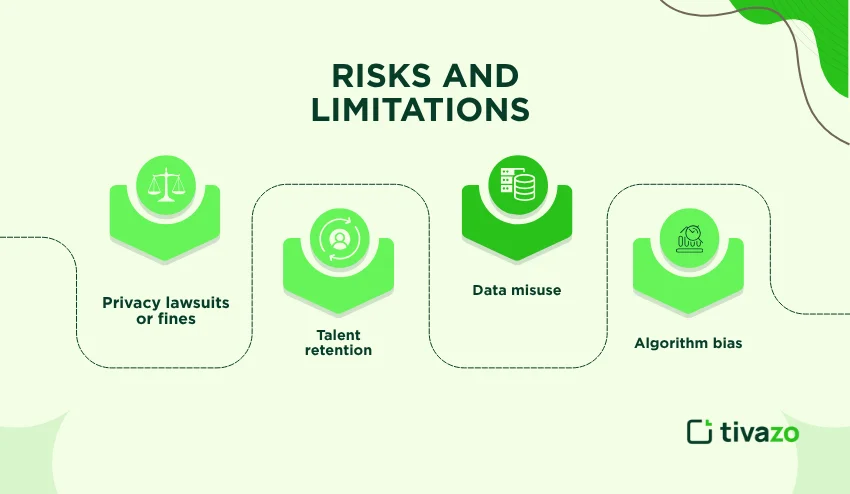
Why Is Tivazo a Smart Solution for Employee Monitoring?
If you are in the evaluation stage of tools you are looking to use for employee monitoring, here is why Tivazo’s employee monitoring statistics solutions stand out from the rest.
What Tivazo Offers You In Its Feature Set
- Time tracking and monitoring: Tivazo provides you with real-time information on clock-ins, idle time, and time tracking by project.
- Alerts: Tivazo instantly alerts your manager if it detects you are inactive. Automating these alerts keeps you focused and only requires a manager’s verification for inactivity.
- Screenshot/Screen capture: Admins can set configurable screenshot intervals to capture their activity while working. You can only see your own screenshot history to maintain a level of transparency.
- Categorization and productivity scores: Websites and apps are categorized as productive, unproductive, and neutral based on your use, which helps managers interpret your use.
- Scalable, flexible options: Tivazo is designed to support you whether you are a small team or an enterprise, with the option of role-based access and reporting.
- Transparency and employee awareness: Tivazo allows you to view your logged time to be transparent and build trust.
- Reporting and analytics: You have access to dashboards and exportable reports (CSV/Excel/PDF) to help you oversee your productive work.
Reasons Tivazo Addresses Common Challenges
- Balancing oversight with trust: By allowing team members visibility to their data, Tivazo reduces the fear of “black box” surveillance.
- Configurable intrusiveness: Admins determine how often to monitor, how in-depth to go, and the types of monitoring, at their discretion under policy.
- Remote and hybrid applicable: Tivazo applies to autonomy as it is designed with distributed teams and has options for remote versus workplace tracking.
- Time and productivity orientation vs. micromanaging: Tivazo focuses on getting the result, not excessive granularity.
- Ethical baseline: Tivazo has features for idle alerts vs. 100% keystroke logging, so there is less pressure.
Considering how common employee monitoring statistics have been (according to many of the employee monitoring statistics above), adopting a monitoring tool such as Tivazo is a great way for organizations to frame monitoring in a thoughtful vs. intrusive context.
Conclusion
Monitoring employee statistics behavior is now a staple of many modern workplaces, particularly in remote and hybrid work, and collects and measures behavior and digital activity, in addition to assessing employee performance, to maximize productivity, security, and efficiency. Participants in remote/hybrid work should not be surprised to learn that a significant percentage of employees report feelings of stress, anxiety, and distrust as a result of too much monitoring. Transparency, fairness, and clarity are much needed to balance and support both accountability and trust among employers and employees alike.
When done with intention and great thought, employee monitoring statistics can provide information to opportunity for managers to improve productivity, process efficiencies, and ultimately richer employee development. For example, Tivazo provides a balanced approach to this monitoring, allowing employers effective visibility while keeping employees informed with ownership and oversight, ultimately providing a systematic approach that increases performance without harming morale.
